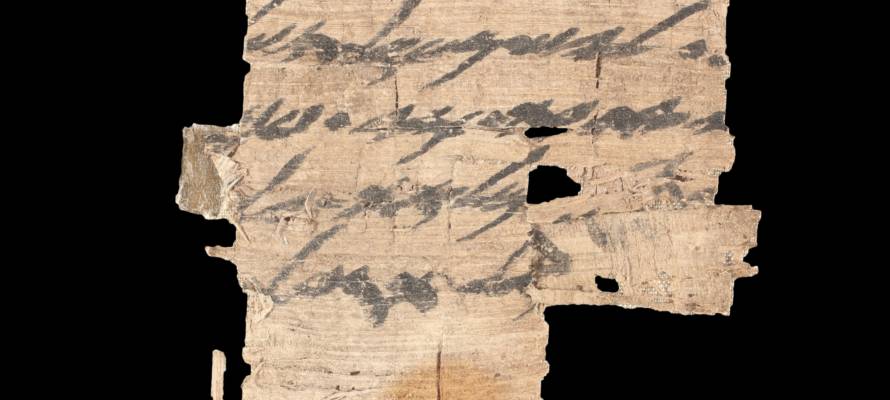The document, dated to the late seventh or early sixth century BCE, is written in ancient Hebrew script on papyrus, and probably originated in the Judean Desert caves.
By TPS
An extremely rare document for the First Temple era, one of only three papyri from this period, was recently returned to Israel following a joint intelligence operation conducted by the Antiquities Theft Prevention Unit of the Israel Antiquities Authority, and Professor Shmuel Ahituv, recipient of the Israel Prize for Biblical Studies.
The document, dated to the late seventh or early sixth century BCE, is written in ancient Hebrew script on papyrus, and probably originated in the Judean Desert caves.
The extremely rare document is composed of four torn lines that begin with the words “To Ishmael send….”, the text hinting that it is a fragment of a letter containing instructions to the recipient.
Based on the writing, it is proposed to date the ‘Ishmael Papyrus’ to the seventh to sixth centuries BCE, joining only two other documents from this period in the Israel Antiquities Authority Dead Sea Scrolls collection. All three papyri come from the Judean Desert, where the dry climate enables the preservation of the documents.
The story began when Dr. Ada Yardeni, a scholar of Ancient Hebrew Script, passed away in June 2018, and Prof. Shmuel Ahituv was asked to complete the publication of a document she was working on. Ahituv was surprised to encounter the photograph of a rare and, until then unknown, document from the First Temple period, together with Yardeni’s preliminary decipherment. This led to a joint campaign by Ahituv and the Antiquities Theft Prevention Unit to locate the whereabouts of the original document.
The intelligence mission succeeded, and the person who owned the papyrus, a resident of Montana, was located. He explained that the papyrus was given to his mother when she visited Jerusalem in 1965, by Joseph Sa‘ad, Curator of the Rockefeller Museum, and Halil Iskander Kandu, a well-known antiquities dealer from Bethlehem, who many years ago sold thousands of Dead Sea scroll fragments.
Back home, his mother hung the framed scroll fragment on the wall.
To persuade the owner to transfer the fragile document to Israel, where it would be conserved in climate-controlled conditions, he was invited to visit the Judean Desert Scroll Department’s Conservation Laboratory in Jerusalem. After the visit, the owner was convinced that here were the best conditions to conserve and research the rare document, and he generously gave it to the Israel Antiquities Authority.
The Dead Sea Scrolls Unit conserved the papyrus and documented it with the modern multispectral system used to monitor the state of the scrolls.
To confirm that the document was genuine, a small sample was radiometrically dated in the Weizmann Institute in Rehovot. The sample provided a date similar to that determined by the paleographic evaluation based on the letter forms, thus consolidating the dating towards the end of the First Temple period.
According to Professor Ahituv, “the name Ishmael mentioned in the document, was a common name in the Biblical period, meaning ‘God will hear’. It first appears in the Bible as the name of the son of Abraham and Hagar, and it is subsequently the personal name of several individuals in the Bible, including Yishmael ben Netanyahu, who murdered the governor Gedaliah ben Ahikam.
It also appears as the name of officials on paleographic finds such as bullae, clay stamp seals, used for sealing royal documents in the administration of the Kingdom of Judah, for example, the bulla reading, ‘To Yishmael, son of the king’. The present document probably certified a dispatch either to or from, Yishmael.”
“Towards the end of the First Temple period, writing was widespread,” says Dr. Joe Uziel, Director of the Israel Antiquities Authority Judean Desert Scrolls Unit. “This is evident from many finds, including groups of ostraca (documents written on pottery sherds) and stamp seals with writing, which have been discovered in many ancient urban settlements, including in the royal capital of Jerusalem.”
“However, First Temple-period documents written on organic materials—such as this papyrus—have scarcely survived. While we have thousands of scroll fragments dating from the Second Temple period, we have only three documents, including this newly found one, from the First Temple period. Each new document sheds further light on the literacy and the administration of the First Temple period,” he said.
Dr. Eitan Klein, deputy director of the Antiquities Theft Prevention Unit of the Israel Antiquities Authority, said that “returning this document to Israel is part of ongoing efforts undertaken by the Antiquities Theft Prevention Unit of the Israel Antiquities Authority to protect and preserve the cultural heritage of the State of Israel, a heritage that belongs to all its citizens, playing a role in the story of the historical heritage of the country and its inhabitants over the centuries.”
“The legal and worthy place for this artifact is in the Israel Antiquities Authority Dead Sea Scrolls Unit, and we are making every effort to retrieve additional fragmentary scrolls located abroad, and to bring them to Israel,” he said.
Do You Love Israel? Make a Donation to Show Your Support!
Donate to vital charities that protect Israelis and help inspire millions around the world to support Israel too!
Now more than ever, Israel needs your help to fight and win the war -- and also the battle of public opinion.
Anti-Israel bias and boycotts are out of control. Israel's enemies effectively use social media to incite brutal terror against innocent Israeli civilians. Please help us fight back!




